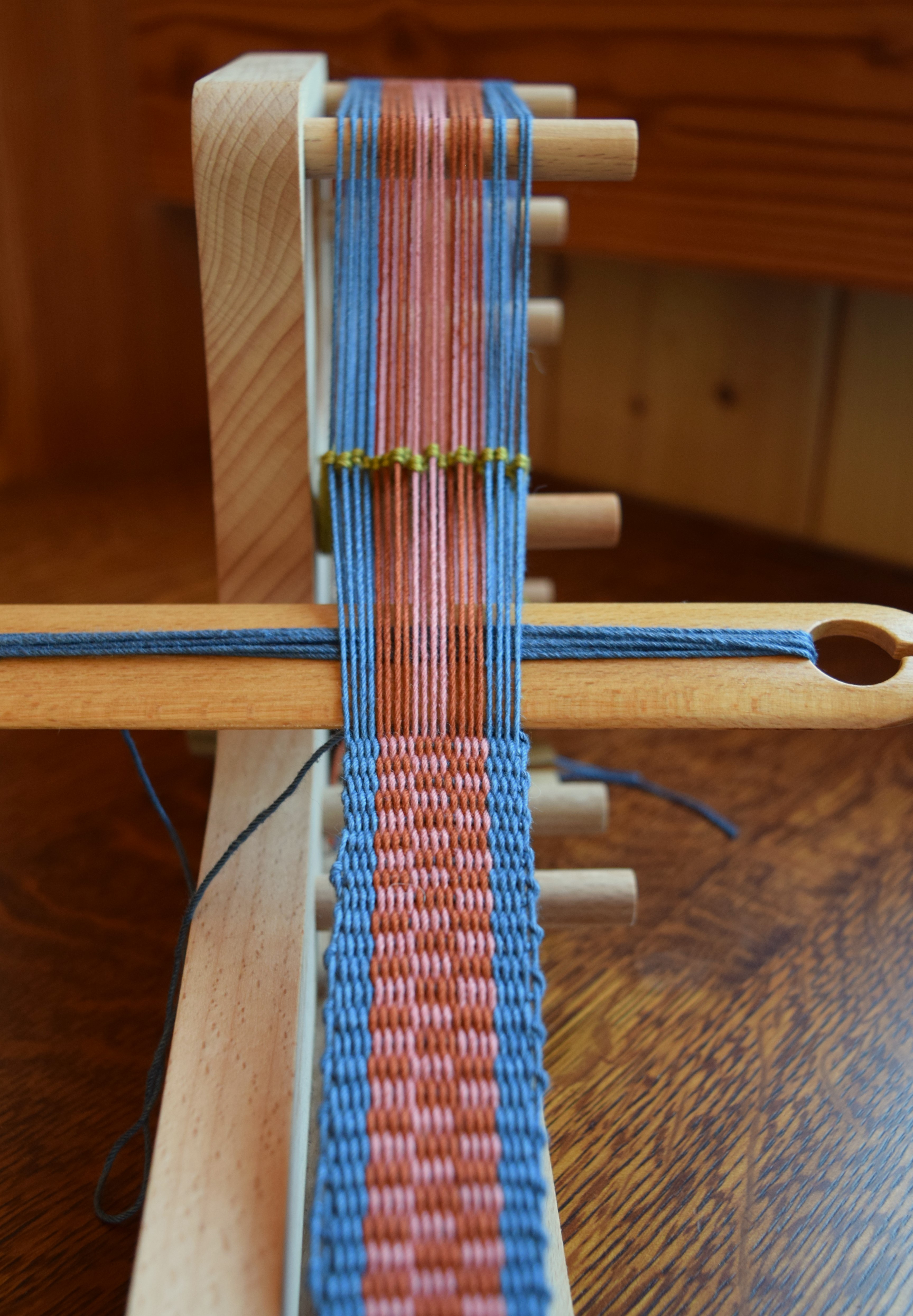
Band #2 , plain weave, and 100% cotton. I’m not sure I really love working with pure cotton. I think I would in pure linen, as it is crisp and alive, but cotton’s worst enemy it seems, if woven without a lot of muscle and confidence, appears slack and lacking resilience. Next project will be pure wool, which I have a lot of. Anyway, learning something new can be more fun when shared with someone else, and fortunately for me Jeff’s daughter Rosanna and I are learning to weave together ! We’re both absolute rank beginners, starting on our Ashford Inklette looms and graduating soon to backstrap looms made in Guatemala. I’ve had a head start by a couple of weeks, while she is waiting until she gets back to Mexico. I thought I might take notes as I weave and post here so she can benefit from my experiments, therefore I will be including Notes To Ro as footnotes at the bottom of my weaving experiments . . .
♣ Notes For Ro ♣
- Ro, you’ll want to read the basic instructions that come with our Ashford Inklettes, about how to warp the loom, and to make the leashes (I’ve done these in the lichen green color, so you can see) and starting with the little pieces of cardboard, which I cut out of the box that our looms came in. From there I go to Laverne Waddington’s Backstrap Weaving Blog for instruction.
- For this band I wove the same plain weave as my first band using color separation for upper & lower shed –held together, side by side without crossing — see Laverne’s video on warping this way, on a narrow warp, what she calls her Plain Weave 2nd Method, shown: Basic Warping for Backstrap Looms. Instead of using warping pegs to separate upper & lower sheds, your inkle loom IS the warping pegs, and you separate the upper/lower (dark/light) as shown on my last project ) On my second band here I am working a variation, what I’m doing different is this: 4 warp threads of dark (rust) on the upper shed/4 light (rose) on the lower, I turn my hand, twisting the threads at the starting peg, thereby switching the colors to be 4 light on the upper/4 dark on the lower, then twist back again for 4 more dark on upper/4 on lower — the edges are the same as the weft thread, 4 upper/4 lower of blue on each side.
- The yarn I am using is Curio#3 (which I sent to you) is 100% cotton, sturdier than the Dishie and has a sheen, so every detail shows off my lackadaisical inconsistent warp & weft tension, beating, and especially my sloppy selvedges. Cotton behaves differently than on my last band which was woven with a wool/cotton blend. Cotton really takes muscle, I should have pulled the weft more, and beat with more force.
- I have been getting in the habit of lifting and lowering the lower shed with my fingers of one hand, then slipping the shuttle in to secure the clear shed, then beat, it is terrific feel-good hand work with minimal fussy tools. I tried using too many tools on my first band, and confused myself !



So meticulous. Even though you say you’re a rank beginner, it looks to me like your’re carefully learning how to make it look pristine. It also looks like so much fun.
It really is a forgiving thing, this humble little Ashford Inklette loom! xx
How fun! I bet that makes the learning curve SO much easier.
I agree with Sorcha. Your attention to detail in that each row is exactly the same in tension and evenness is amazing. I love to see those bands wrapped around wool or flax on a distaff. I use ribbon but it’s just not as lovely looking as a colorful hand woven band holding the flax in a bundle on the spinning wheel. I just really love them.
So happy to see you pop in, and I hope your summer is magical ! xx
You’ll have to try one of these Inkle Looms, they’re great fun! Oh, so I look forward to useing wool, handspun even (or Unspun) and working in Fair Isle motifs…. which I know will be great finishes for a plain sweater. xx
Oh! Virginia, I will for sure be working some fine 60/2 100% silk soon, to make ribbons…. you could very well make these and still remain within distaff dressing tradition!